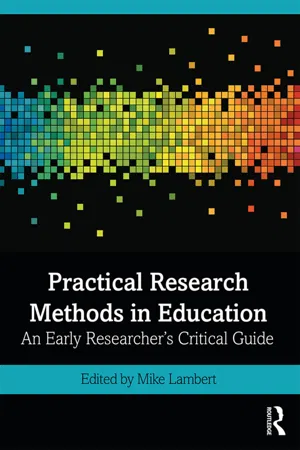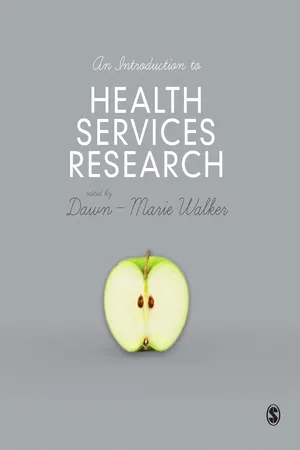Psychology
Quantitative Data
Quantitative data in psychology refers to numerical information that can be measured and analyzed using statistical methods. This type of data is used to quantify behaviors, attitudes, and other psychological variables. It provides researchers with objective and precise measurements, allowing for statistical analysis and the identification of patterns and relationships within the data.
Written by Perlego with AI-assistance
Related key terms
6 Key excerpts on "Quantitative Data"
- eBook - ePub
Practical Research Methods in Education
An Early Researcher's Critical Guide
- Mike Lambert(Author)
- 2019(Publication Date)
- Routledge(Publisher)
It is still common for researchers working in the education field to regard ‘quantitative-qualitative’ as a methodological divide, in which they have to choose a side. This chapter rejects this view, taking as its starting point the notion that researchers should view them merely as different types of data and that they therefore need to understand how both are collected, analysed and interpreted. As using the quantitative option can seem particularly problematic, here are three reasons why readers who are nervous of numbers should consider familiarizing themselves with Quantitative Data processes:What is quantitative research? What are Quantitative Data?• Having some understanding of Quantitative Data will improve your ability to assess investigations which use quantitative approaches, particularly if you are new to research.• Being able to incorporate Quantitative Data into your own research could strengthen its impact, particularly if you are interested in influencing aspects of education practice or policy. Although they often use them carelessly and unreflectively, policymakers like numbers.• Having an improved understanding of Quantitative Data and research will put you in a better position to evaluate or conduct mixed-methods investigations.The application of quantitative methods in social-science research derives from interest in the 19th century in experimental investigation in the natural sciences. This sought to understand the processes of cause and effect through manipulation and controlled testing. However, it became clear that many of the issues explored in social sciences, such as education, do not lend themselves well to experimental approaches, so researchers began from the 1950s to apply them to what became known as ‘quasi-experimental’ and ‘non-experimental’ situations – these approaches are considered in more detail later in the chapter.Provocatively, Berliner (2002:19) has described what social scientists, and particularly educational researchers, do as the ‘hardest to do science […] because humans in schools are embedded in complex and changing networks of social interaction’. It is engaging with this social complexity that makes the application of experimental research to education so challenging (Hadfield and Jopling, 2018), and it is partly as a consequence of the need to address this complexity and the limitations of the persistent quantitative-qualitative divide, manifested in the so-called ‘paradigm wars’, that mixed-methods research design (Tashakkori and Teddlie, 1998) gained ground in the 1990s. - eBook - ePub
- Sandra van Thiel(Author)
- 2021(Publication Date)
- Routledge(Publisher)
Analysing Quantitative DataThe aim of this chapter is to offer an introductory guide to researchers who are new to using Quantitative Data. It is not my purpose to provide an exhaustive review of all possible statistical techniques and formulae. A single chapter would not suffice – besides, there are plenty of other, specialized textbooks on statistics in general and on specific statistical techniques. The focus here will rather be on the different phases of analysing Quantitative Data. I shall also give an overview of a select number of statistical techniques and discuss their suitability for answering certain research questions.When applying statistical techniques, it is always a good idea to seek some external advice first: from other researchers, from specialists in research methods and techniques, by consulting textbooks or using the help function of the computer program employed for analysis. Do not be intimidated by statistics! Researchers have to be able to think logically but need not be mathematicians in order to be able to conduct a quantitative study.Broadly speaking, a study with Quantitative Data consists of three phases: data collection, data ordering and data analysis. All three phases will be discussed. The chapter concludes by listing a few points worthy of consideration with respect to the reliability and validity of Quantitative Data.10.1 Quantitative DataQuantitative Data are always numerical in kind. They can either be numbers that have a certain intrinsic meaning (such as money in your local currency, a date or a number of units of something), or consist of numerical scores (for example, an evaluation of a respondent’s answer on a scale from 1 to 10). Researchers can assign scores to all kinds of variables. For example, the replies given by a group of respondents to the question ‘Which political party did you vote for during the last elections?’ can be quantified by assigning a separate score to every possible answer (for example, 1 = Conservative; 2 = Liberal Democrat; 3 = Labour). The score number constitutes a shorthand way of expressing a respondent’s answer. - eBook - ePub
An Introduction to Health Services Research
A Practical Guide
- Dawn-Marie Walker(Author)
- 2014(Publication Date)
- SAGE Publications Ltd(Publisher)
19 Quantitative Analysis Nick Taub Dawn-Marie WalkerLearning Objectives
- To appreciate the role of quantitative analysis
- To understand what the different types of data are: numerical and categorical
- To be aware of the importance of getting data ready for analysis, including coding and handling missing data
- To know what standard deviations, confidence intervals and p-values are
- Understand the purpose of some common methods of analysis of numerical data
Introduction
Quantitative analysis, also known as statistical analysis, is the process used by researchers to obtain results from data – that is, to get ‘facts from figures’ (Moroney, 1975). This process is needed in almost all quantitative studies because their aim is usually to answer questions related to a very large group of people, i.e. the target population, using data collected on just a small sample (please see Chapter 17 : ‘Sampling’). The overall purpose of an analysis is to answer the questions, including testing hypotheses, that the study sets out to answer, and it should be done in a way that is systematic, understandable and accepted as valid by readers.Case Study
Some researchers were conducting a small quantitative project. The first step in the project was collecting survey data:- What is your age in years?
- What sex are you? Female……..□ Male…….□
- What is your weight in kilograms?
- What colour are your eyes? Blue □ Green □ Brown □ Grey □ Black □ Hazel □ Other □ (Please specify)_____________
- Do you carry out more than 2 hours of exercise per week, on average? No…….□ Yes……..□
- What kind of organisation do you work for? Primary Care □ Hospital □ University □ Local authority □ Other □ (Please specify)……………………………
- Which blood group do you belong to? A□ B□ O□ AB□ Don't know □
Types of Data
The choice of the information requested in the questionnaire in the case study illustrates the different forms of data. The type of data affects both the best ways of summarising and describing it, and also the best ways of analysing it. The most important distinction is between numerical data and categorical data (please see Figure 19.1 - eBook - ePub
- Graham C. Davey(Author)
- 2018(Publication Date)
- Wiley(Publisher)
- Findings published in scientific journals will reach a wider audience and peer review of submitted papers ensures that high quality is maintained. However, even published papers might be flawed and caution must be exercised when the results are being followed up.
- Publishing work in books is another means of dissemination but has the disadvantage of the results appearing dated because of the lengthy prepublication period.
- Broad exposure can come from talking to the media. However, the media are prone to oversimplification and may distort the findings to create a more dramatic story.
QUANTITATIVE RESEARCH METHODS
LEARNING OBJECTIVE 2.3
Demonstrate understanding of some of the quantitative methods used by psychologists.Psychologists use a wide variety of methods in order to study behaviour scientifically. Each has its own strengths and weaknesses, as outlined in the discussion below. In many cases, a psychological phenomenon will most fully be understood by tackling it with a variety of methods, a process known as ‘converging operations’.Most psychologists use ‘quantitative’ methods, investigating behaviour with procedures modelled on those used by the natural sciences. Typically they will use experiments and observational methods to obtain numerical data that are subjected to statistical analyses. A sizeable minority of psychologists use ‘qualitative’ methods, rejecting these quantitative methodologies in favour of more interpretative techniques such as in-depth interviewing and textual analysis.What constitutes ‘good’ research? Reliability, validity, and importanceGood research has three attributes: reliability, validity, and importance. Reliability simply refers to how reproducible the results are. If you did the study more than once, would you get similar results each time? Validity - Terry Hanley, Clare Lennie, William West(Authors)
- 2012(Publication Date)
- SAGE Publications Ltd(Publisher)
There are most certainly very qualitative approaches that can be taken to observations, for example immersing oneself in a culture and undertaking an ethnographic study in watching the world around you, but quantitative measures can also be employed in making sense of looking at things. However, in order to do this, we need to be sure we know what the thing is that we are looking at or for. If we return briefly to the chicken soup scenario, would it have been logged as dessert, chicken and sweetcorn soup or chicken soup? We might, for example, look at gender differences in aggression using observations, but beforehand we would have to create a scale of behaviours we believe constitute aggression and some sort of agreed rating of these. To some extent the PCEPS and CTS-R scales that were discussed above are an attempt to capture what we might mean by good practice in therapy. Whilst we see the discussion and disagreement on the rating scales as a useful vehicle on which to assess a trainee’s development, this discussion brings with it a disadvantage to the world of quantitative research in terms of limiting the extent to which it can be considered as ‘water-tight’ and so allowing for it to be worked with as parametric data. In order to assess the reliability of the data obtained, researchers often double-rate the same event and look to see the extent to which their scores compare (inter-observer reliability). We might then be able to present that data collected for further statistical analysis, to see if there are any significant differences occurring between boys and girls and their levels of aggression (however we define this).It is now to methods of data analysis that we turn.Making sense of numbers: data analysis
It is often this part of the discussion that is the most stress-inducing for those who are rather more averse to numbers. When we introduce the dreaded statistics to our trainees, we make it clear that the intention of the session is just to outline the use of numbers and the ways that they can be of use in counselling and psychotherapy research. In terms of analysis, we always say that we will give you a flavour of what can be done and, should you want to go into further depth, we will guide you to additional resources and people. This chapter is no different. We hope that we have kept you with us so far, and in the closing sections we offer what are hopefully digestible definitions of some statistical terms that you might well come across, along with some additional reading, should you want to take your quantitative musings further.As outlined above, the type of data that we collate drives the types of analysis that we can perform on it. If we have higher-level data (interval or ratio data to use the precise terms) then we are able to undertake statistical tests that tell us something about the significance of any relationships or patterns. We will come to this in a little while, but for now let’s keep things simple.- John McLeod(Author)
- 2013(Publication Date)
- SAGE Publications Ltd(Publisher)
One possibility for the researcher would be to meet with the client after each session for a tape-recorded interview, and ask him or her to talk about what they felt during the session. This research strategy would yield a rich descriptive account or story, probably containing metaphors (‘I felt as though I was going to explode’) and idiosyncratic references to personal experience (‘I felt just like I did when I was told I had lost my job’). This type of data is ‘qualitative’: experience is encoded through an infinitely flexible language system. However, although qualitative data can be evocative and meaningful, it is difficult and time-consuming to move from the richness of an individual story to a systematic comparison across stories. If the researcher intends to compare the experiences reported by this informant with those elicited from other participants in the research, or wishes to test the hypothesis that feelings change at different stages in counselling, a different approach will almost certainly be required. In such a situation, the application of quantitative methods makes it much easier to collate data across a number of people.The aim of this chapter is to offer a balanced account of the role of quantification in counselling and psychotherapy research. Consideration is given to the advantages of quantification in relation to the pursuit of certain types of research question, and also the limitations and dilemmas arising from attempts to quantify human experience.Exercise 6.1 Your own position on quantification
What is your own attitude towards the use of quantitative methods in the study of therapy process and outcome? Do you regard it as essential, or as misguided? Or do you adopt a more balanced viewpoint? What are the sources of these attitudes, in terms of your life experience and education? If possible, discuss this topic with colleagues whose position differs from your own. What have you learned from these exchanges?The possibilities of quantification
Quantitative Data consist of information about some aspect of human experience, or some personal attribute, that has been transformed into numbers. Always, when quantitative methods are being used, it is essential to remember that what is being measured can also be described in words. For instance, we can say that one person is ‘tall’ and another is ‘short’ and therefore that one of them is ‘taller’ than the other. Quantitative methods allow these kinds of statement to be made with greater precision. We can then say that the first person is 185 cm in height and the second person is 170 cm in height and that the difference between them is 15 cm. The application of quantitative methods in research has a number of advantages:1 Statements can be made over which there is a large degree of intersubjective agreement. We may dispute just what counts as ‘tall’ (does 180 cm count as ‘tall’?), but we can all agree on what we mean by a foot or an inch. Quantification therefore introduces objectivity and reliability into research.
Index pages curate the most relevant extracts from our library of academic textbooks. They’ve been created using an in-house natural language model (NLM), each adding context and meaning to key research topics.





